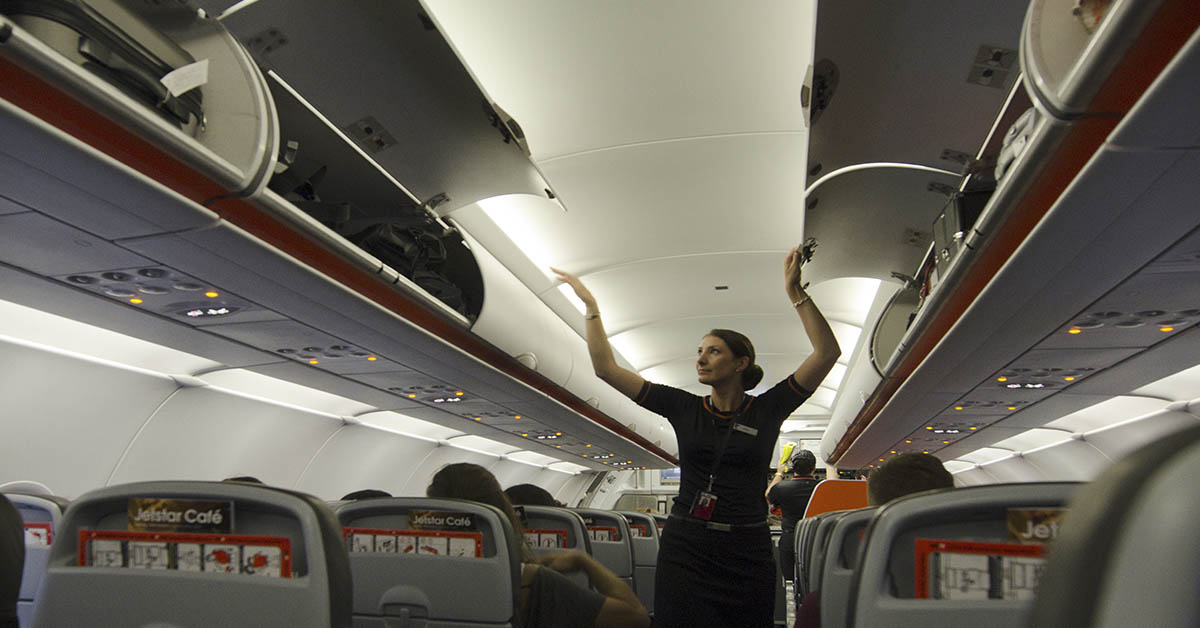In the realm of air travel, the role of flight attendants extends far beyond serving beverages and ensuring passengers’ comfort. They are trained professionals responsible for ensuring the safety and well-being of everyone on board. One seemingly peculiar practice stands out among the many procedures and protocols they adhere to—the bracing position adopted by the cabin crew during takeoff and landing.
The Bracing Position Explained by a flight attendant

When passengers observe flight attendants buckling up in their jump seats and sitting on their hands during landings, it often sparks curiosity and speculation. However, Henny Lim, a flight attendant with Cebu Pacific, explains in a viral TikTok video. There’s a method to this seemingly unusual posture.
Lim elucidates that the bracing position involves a series of specific actions. Fastening seatbelts securely, sitting upright, placing hands on thighs with thumbs tucked, keeping arms loose. And lastly, ensuring feet are flat on the floor.
Purpose of the Bracing Position

The primary objective behind the bracing position is to minimize bodily movement during potential emergencies. Thereby reducing the risk of injury upon impact. By assuming a rigid posture and securing themselves in their seats, flight attendants are better prepared to withstand the forces exerted during a crash landing.
During this period, flight attendants engage in what Lim calls a “silent review. ” Mentally preparing themselves for emergency scenarios by familiarizing themselves with emergency equipment, door operations, commands, and observing visual cues outside the aircraft.

Insights from Regulatory Authorities
The importance of the bracing position is underscored by regulatory authorities like the Federal Aviation Administration (FAA). According to a memo from the FAA, the bracing position serves two primary purposes: reducing flailing and minimizing secondary impact. Flailing, or uncontrolled movement of limbs, can lead to additional injuries during a crash.
By adopting the bracing position, occupants can mitigate this risk. Furthermore, prepositioning the body, particularly the head, against the surface it would strike during impact helps reduce the severity of secondary impact injuries.
Read More: 7 Things Flight Attendants Notice About You When You Board an Airplane
Flight Attendants’ Perspectives on Safety
Henny Lim’s insights into the bracing position are part of a broader trend where flight attendants use social media platforms like TikTok to educate passengers about safety protocols and share their experiences.
Flight attendant Destanie, for instance, has gained attention for revealing the wild antics passengers pull in a bid to get a seat upgrade. While these anecdotes may entertain viewers, they also highlight the importance of adhering to safety protocols and respecting the professionalism of flight attendants.
Challenges and Rewards of the Profession
Flight attendants like Destanie and Esther Sturrus provide candid insights into the challenges and rewards of their profession. While they acknowledge the difficulties, such as dealing with difficult passengers and working in high-pressure environments, they also express gratitude for the lifestyle and opportunities their job affords them. Despite the challenges, their dedication to ensuring passenger safety remains unwavering.
The bracing position adopted by flight attendants during takeoff and landing is not merely a ritual. It’s a crucial safety measure aimed at minimizing the risk of injury during emergencies. Through the insights of professionals like Henny Lim, passengers gain a deeper understanding of the rationale behind this practice and the meticulous preparation that goes into ensuring their safety.
As flight attendants continue to share their experiences and expertise, passengers are empowered to approach air travel with greater awareness and appreciation for the dedication of those entrusted with their safety.
Read More: The Seven Secret Words On A Flight That Means There’s Danger
Sources
- “Flight attendant reveals fascinating reason why cabin crew sit on their hands during takeoff and landing” Mail Online. Rachel Summer. February 26, 2024.
- “Flight attendant shares the ‘scary’ reason airline staff sit on their hands during landing” Daily Express US. Katherine McPhillips. February 28, 2024.

